November 9, 2012
Air Date: November 9, 2012
FULL SHOW
SEGMENTS
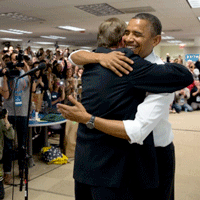
The Environment and President Obama’s Second Term
View the page for this story
Americans have voted to give President Obama a second term. Now he has four more years to make progress on environmental issues, such as climate change. Host Steve Curwood discusses the possible environmental priorities with ConservAmerica’s Vice President for Government and Political Affairs, Dave Jenkins, and the Natural Resources Defense Council’s Director of the Climate and Clean Air Program, Dan Lashof. (11:35)

Adapting Cities to Climate Disruption
View the page for this story
Superstorm Sandy drew some of its strength from warmer waters, exacerbated by climate change. Elliott Sclar, director of the Center for Sustainable Urban Development at the Earth Institute at Columbia University tells host Steve Curwood how to design urban areas to be more resilient in a warming world. (07:05)
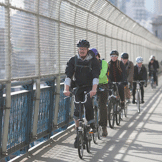
Biking in the Storm
View the page for this story
The number of cyclists on New York City streets spiked after Superstorm Sandy. Caroline Sampanaro, director of bicycle advocacy at Transportation Alternatives, joins us to discuss the importance of the bike to helping create sustainable cities. (04:00)
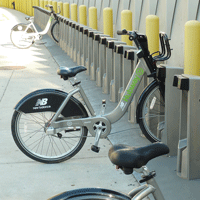
Power Shift - Bike Sharing in Boston
/ Bobby BascombView the page for this story
Bike share programs are increasingly popular, with nearly 200 world wide. In Boston the Hubway allows riders to take out a sturdy bike for 30 minutes at a time to help commuters the last mile of their commute. Living On Earth's Bobby Bascomb reports. (08:20)
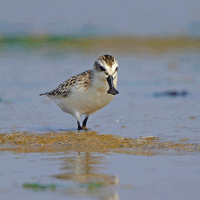
BirdNote ® Spoon-billed Sandpiper
/ Gerrit VynView the page for this story
One of the rarest birds in the world migrates to the far northeast of Russia to breed each summer. Cornell Laboratory photographer Gerrit Vyn reports. (02:10)
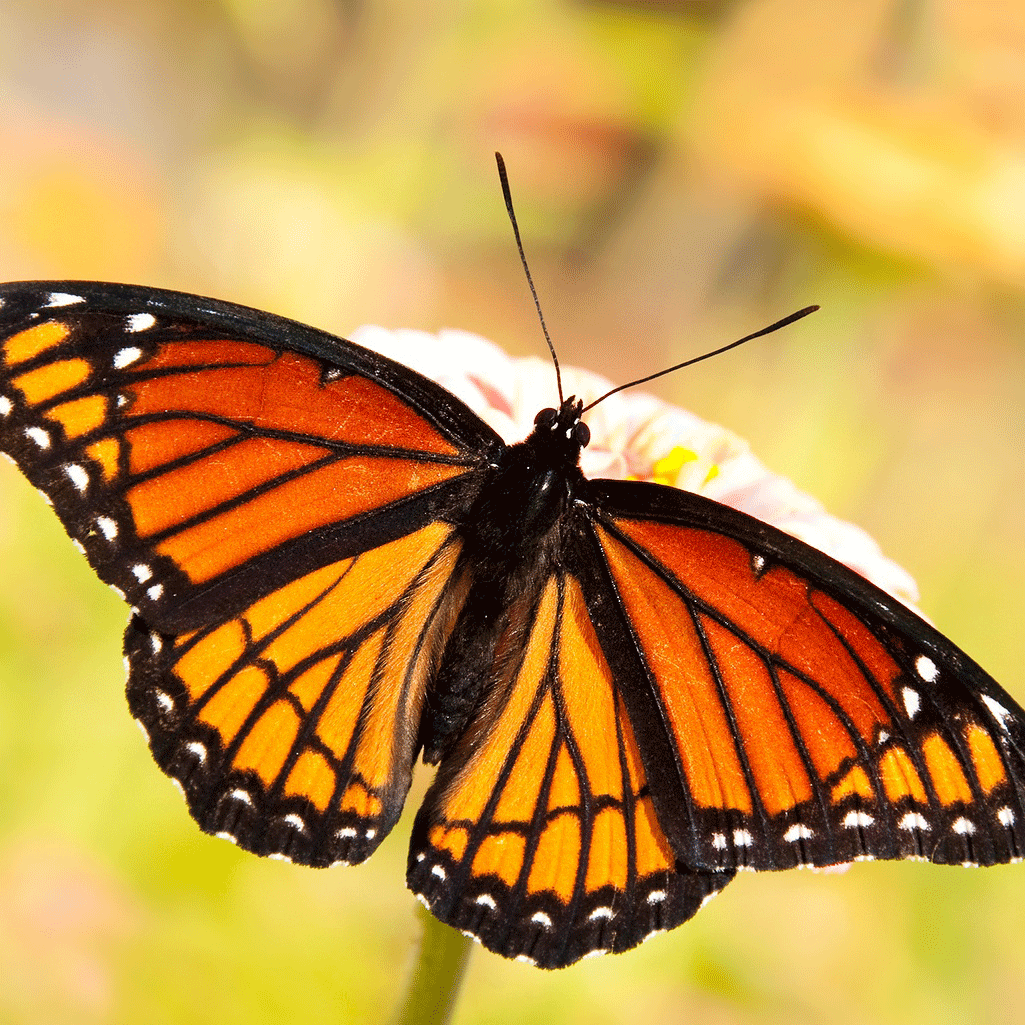
Flight Behavior
View the page for this story
Best selling author Barbara Kingsolver’s newest novel takes place in a small Appalachian community in rural Tennessee. The farming town gets international attention when climate change causes the unexpected arrival of a huge collection of beautiful winged creatures. Barbara Kingsolver talks with host Steve Curwood. (14:30)
Show Credits and Funders
Show Transcript
HOST: Steve Curwood
GUESTS: Dave Jenkins, Dan Lashof, Elliott Sclar, Caroline Samponaro, Barbara Kingsolver
REPORTERS: Bobby Bascomb, Gerrit Vyn
[THEME]
CURWOOD: From Public Radio International - this is Living on Earth, I'm Steve Curwood. With the 2012 elections in the history books, what’s next for US environmental policy, and the prospects for a comprehensive plan to address the threat of global warming.
LASHOF: Well I think the President certainly recognizes that action on climate change is the big unfinished item on his agenda for the first term and that he'll try to move that forward.
CURWOOD: But can the President get bipartisan buy-in? Also - sprouting up in cities from Boston to Beijing - a low-cost low-emission solution to urban gridlock: public bike-share programs.
MULLEN: Bike-sharing is a rocket ship. If you think about transit investment it’s the best bang for the buck by a factor of 100. And then if you think about the public health aspects. I don’t know of any other modes that are as much a magic bullet as cycling is.
CURWOOD: We'll have that and much more this week on Living on Earth, stick around!
[THEME]
ANNOUNCER: Support for Living on Earth comes from Stonyfield Farm.
The Environment and President Obama’s Second Term
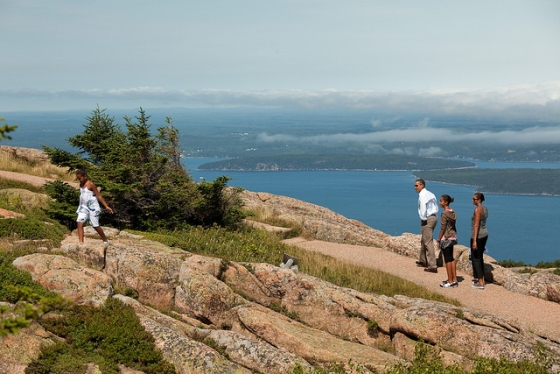
President Barack Obama and his family hike on Cadillac Mountain at Acadia National Park in Maine, July 16, 2010. (Official White House Photo by Pete Souza)
CURWOOD: From the Jennifer and Ted Stanley Studios in Boston, this is Living on Earth. I'm Steve Curwood. On November sixth, after a marathon of rancorous campaigning, Americans voted to give President Obama four more years to deliver on the hopes that swept him to power in 2008.

President Barack Obama in the Oval Office, Sept. 28, 2012. (Official White House Photo by Pete Souza)
OBAMA: But despite all our differences, most of us share certain hopes for America’s future. We want our kids to grow up in a country where they have access to the best schools and the best teachers — (cheers, applause) — a country that lives up to its legacy as the global leader in technology and discovery and innovation — (scattered cheers, applause) — with all of the good jobs and new businesses that follow. We want our children to live in an America that isn’t burdened by debt, that isn’t weakened by inequality, that isn’t threatened by the destructive power of a warming planet. (Cheers, applause)].
CURWOOD: That warming planet is one of the most profound challenges that faces the president in his second term. We have two informed observers to discuss what the elections might mean for that and other environmental issues – ConservAmerica’s Vice President for Global and Political Affairs, Dave Jenkins. Hello Dave!
JENKINS: Hi, how are you doing?

Dave Jenkins, Vice President of Government and Political Affairs at ConservAmerica (formerly Republicans for Environmental Protection)
CURWOOD: And, on Skype, also from Washington, is the Natural Resources Defense Council’s Director of Climate and Clean Air program, Dan Lashof. Hi there, Dan!
LASHOF: Hey Steve.

Dan Lashof, Director of NRDC’s Climate and Clean Air program
CURWOOD: Dave Jenkins, millions of dollars from corporate sources, particularly the fossil fuel interests, were spent over this past election cycle, but at the end of the day, pretty much the status quo. What is the lesson here, do you think?
JENKINS: I think the lesson here is that all that money poured into the Republican side, and yet the message that they were putting forth on television didn’t reflect the kind of forward-thinking, taking care of future generations, being responsible – these values that most people define as Conservative.
They were more of an all-in, you know, live for the day… drill, baby, drill! Talking about a war on coal when you know, people know that the reason that coal is being displaced is because of natural gas and the marketplace… far more so than regulation. You look at the constituencies, you want to appeal to young people, you want to appeal to minorities, you want to build a winning coalition the way Reagan did back in the 80s.
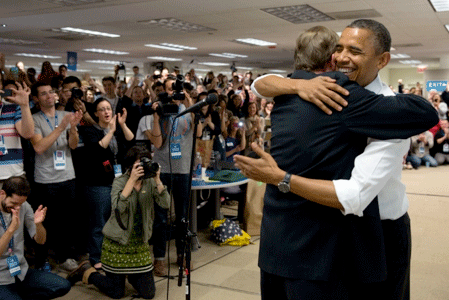
President Barack Obama hugs his campaign manager, Jim Messina, during an unannounced stop at his campaign headquarters in Chicago, Ill., Nov. 7, 2012. (Official White House Photo by Pete Souza)
And the polarizing rhetoric, and everything that really was sort of enhanced simply with all that industrial and corporate money – no matter how much you broadcast it on TV, if it’s not a message that resonates with the American public, you’re not going to get through. My hope is that our party will be skeptical of the agenda and the items that special interests put forward, and try to take a step back and think about it in the context of the best interest for the nation as a whole.
CURWOOD: Dan Lashof, what’s the lesson here – all that money for the election and we’re really still at the status quo.
LASHOF: Well, I think we’re even better off than the status quo in terms of the make-up of the Senate. And when all is said and done, I think it will turn out that the fossil fuel industry spent 500 million dollars trying to defeat people who had the temerity to suggest that we need to invest in renewable energy and deal with climate change, and they lost… in every case.
So, we have coming to the Senate, some real champions such as Martin Heinrich in New Mexico and Tammy Baldwin in Wisconsin, Tim Kaine… the coal industry spent millions of dollars trying to defeat him in Virginia and they failed, Angus King, a strong independent from Maine who will… is a champion of dealing with climate change. So, ultimately, the lesson is that money can’t buy you love if what you’re trying to sell is a fossil fuel future that is bad for the country.
CURWOOD: Let’s just take a look for a moment at the ballot initiatives… you know when people feel like they have to go around their legislatures when they’re really frustrated when they go to the legislatures, when legislators are blocking things they think, “oh, the ballot initiative.” We saw that on initiatives like gay marriage and marijuana… most of these initiatives won, but most of the environmental measures went nowhere. What happened with the labeling of genetically modified organisms in California, or Michigan’s renewable fuel standard?
LASHOF: Well, on the Michigan standard, the argument that the opposition put in on Michigan wasn’t about the substance, it was an argument that this shouldn’t be done through a Constitutional amendment, and I think that they’re there so… so the answer there is that that mechanism was the wrong mechanism for moving renewable energy forward. The public strongly supports moving renewable energy forward, and so that’s a bit of an anomaly.
And, in California, I think that may be one of the few examples where money really did influence the outcome – Big Ag really did put millions of dollars into defeating that proposition. And propositions are hard to win – there’s kind of a strong bias overall for people to vote ‘no’ and when you have a lop-sided investment of money, it’s very hard to prevail.
CURWOOD: Dave Jenkins?
JENKINS: Yeah, I agree with what Dan said, but I would also add though, that if you look a little deeper and you look at ballot initiatives for open space and parks, and those are overwhelmingly supported by people of every political stripe, and I think that goes to a better quality of life desired by folks and that everybody agrees that we need to be responsible when it comes to land stewardship. So, there’s no real negative wave or anything like that with respect to environmental ballot initiatives, I don’t think that any of these things really lost on their merit.
CURWOOD: I want to ask you both about the prospects now for the Keystone XL pipeline. Dave Jenkins, do you think that this is a good thing for the President to block, and do you think that he has the political capital to do so if he wants to?
JENKINS: When you’ve got a little bit more conventional-type oil reserves up in North Dakota and places like that, for me it doesn’t make a ton of sense to bring that carbon-intensive fuel here and have a pipeline here going all the way to the Gulf of Mexico where there’s decent odds that that product wouldn’t even be sold to Americans, that that product would just be shipped over to China.
So, I’d hope that the State Department and the President, you know, look at it carefully and consider all the impacts and make an informed decision. But I don’t think Congress would be quite as in a position to block his action as it was before. One, he’s not standing for re-election again and two, he’s got two more extra Democrat votes in the Senate.
CURWOOD: Dan Lashof?
LASHOF: So, on the Keystone XL pipeline, the administration needs to complete the environmental review process that they’ve started. We think that it’s very clear that the conclusion of that should be to reject the pipeline as not in our national interest. It is a pipeline that would bring one of the dirtiest sources of fossil fuels and the President should stick with his focus of improving efficiency, supporting renewables, and moving the country towards a clean energy economy as he has talked about.
CURWOOD: How much do you think this huge federal deficit is going to affect science and research funding going forward now? Dan Lashof?
LASHOF: Well, I think the deficit is a big problem and how the ‘fiscal cliff’ is addressed is going to impact both science research and energy research and investments in environmental protection and infrastructure as well as I think, you know, in the aftermath of Sandy, the clear need is to invest in preparing for the effects of climate change that we can no longer address.
So, we certainly think that that needs to be solved in a way that has a balance between raising revenue, and that spending cuts have to be carefully targeted and should be things like cutting fossil fuel subsidies. So, whether that’s solved in a bipartisan way I think will set the tone for how policy is addressed throughout the second term.
CURWOOD: Dave Jenkins, funding for science and research?
JENKINS: The funding, it needs to be reduced in a balanced way across the different areas. And what we saw in the last Congress was an effort by some to target things like the Endangered Species Act and target clean energy and Land and Water Conservation Funding, and things like that. And disproportionately, as apart of a sort of ideological sort of Libertarian-type agenda, and that’s not in the nation’s best interest.
If you’ve got to tighten your belt and you’ve got to take serious cuts - what you want to do is do it in a balanced way, you can’t starve this important area of what our country needs to go forward.
CURWOOD: Superstorm Sandy reminds us that climate disruption is on a track to wreck our civilization. The President, when our election was over, talked about wanting to leave a safe planet for the next generations, but the present path of the White House would not do that, many scientists say. Do you think Obama is going to be able to reach out and find the sort of intestinal fortitude that allowed him to plow ahead with the healthcare measures in the face of the incredibly stiff opposition to dealing with climate change? Dave Jenkins?
JENKINS: Yeah, I mean one of the things that we really fault President Obama for is that when there was an opportunity for climate legislation on Capitol Hill, he seemed to want to stand back and let the folks in Congress lead the way, and didn’t really provide a lot of leadership on that.
Now, the only way he moves forward and really doubles down and tries to do something big, is if he brings Republicans along in the effort. And if the President’s not out there using the bully pulpit to rally support, odds are politicians are not going to have the courage to stand out and address the issue.
CURWOOD: Dan Lashof?
LASHOF: Well, I think the President certainly recognizes that action on climate change is one of the big unfinished items on his agenda from the first term and that he’ll try to move it forward. And I agree with Dave that he needs to lead on this issue.
I don’t expect that he’s going to get a lot of bipartisan consensus in the Congress. I think that he can develop a consensus among a majority of – you know Democrats and Republicans – in the public who want to see action. He needs to do more to lead and bring people together around steps that he has the authority to take to reduce carbon polution on the one hand, and to better prepare the country to deal with the consequences of climate change, things like Hurricane Sandy, on the other. And I think he can and I am optimistic that he will.
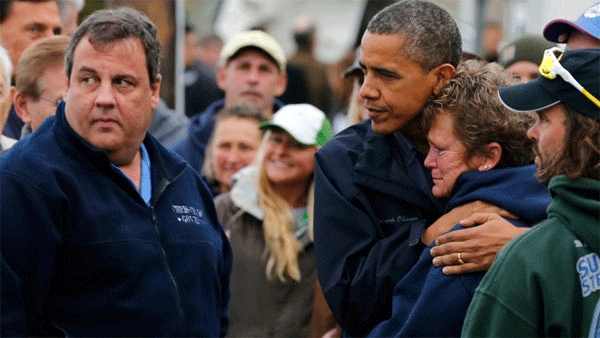
President Barack Obama hugs Donna Vanzant, the owner of North Point Marina, as he tours damage from Hurricane Sandy in Brigantine, N.J., Oct. 31, 2012. (Official White House Photo by Pete Souza)
JENKINS: Let me add that the President needs to be out front and leading and trying to convince average Americans. And he needs to do that, not sort of like Al Gore does, trying to own the issue himself, he needs to have partners - bipartisan partners that also advance that cause so that the message reaches Americans of all political stripes. And we’ve got to all move together forward on this if we’re going to expect folks in Congress to wake up and decide to do something.
CURWOOD: Dave Jenkins is Vice President for government and political affairs for ConservAmerica, thank you so much, Dave!
JENKINS: Thank you!
CURWOOD: And Dan Lashof is Director of the Climate and Clean Air program of the Natural Resources Defense Council – thanks so much, Dan.
LASHOF: Thanks, Steve!
Related links:
- Dave Jenkins’s profile on ConservAmerica’s site
- Dan Lashof’s profile on the Natural Resources Defense Council’s website
- ConservAmerica
- Natural Resources Defense Council
[MUSIC: Booker T and the MG’s “Melting Pot” from Melting Pot (Stax Records 1983).]
CURWOOD: Just ahead – finding smart ways to adapt to the new realities of superstorms like Sandy. Stay tuned to Living on Earth!
[CUTAWAY MUSIC: Stuff: Signed, Sealed, Delivered” from Live At Montreaux 1976 (Eagle Rock Music 2008).]
Adapting Cities to Climate Disruption

Pumping water out of New York City. (US Army Corps of Engineers)
CURWOOD: It’s Living on Earth, I'm Steve Curwood. The Superstorm called Sandy was a wake-up call in the US, laying bare the vulnerabilities of our built environment in the face of dangerous new realities of climate disruption. Rising sea levels and severe storm surges target coastal communities, and many towns and cities are inadequately protected.
So the question is, what are we going to do about it? It's the kind of problem that engages thinkers like Dr. Elliott Sclar. He directs the Center for Sustainable Urban Development at Columbia University's Earth Institute - and joins us by skype welcome to Living on Earth!
SCLAR: Thank you, it’s nice to be with you!
CURWOOD: So, how surprised were you by that damage that was caused by Hurricane Sandy?
SCLAR: Well, I was surprised and I wasn’t surprised. I obviously was surprised by the timing of it and knowing what the actual extent of the damage was, but as an economist and as an urban planner who deals with sustainable cities, the notion that this was going to happen was not something that came out of the blue to me. So, in that sense, it was kind of one of those moments when you know… well, I told you so. But I didn’t say that because it’s really a serious problem for lots of people.
CURWOOD: A lot of the efforts at climate change legislation in this country, really around the world, have been aimed at reducing emissions. What should we be doing now to get a coherent policy on adaptation?
SCLAR: That’s a very important point. While we do have to mitigate, even if we were to end all greenhouse gas emissions tomorrow, there still would be a major problem going forward because of all of the carbon that’s accumulating in the atmosphere already.
The real question is: What are we going to do to adapt to the new realities of the climate that we face. Some of the answers that you’re hearing are probably technical ones – protection against storm surges for coastal communities is one of the things that you hear, hardening infrastructures against flooding conditions. The issue that we face is how are we going to begin to accomplish the kinds of changes that we need to put in place.
As you know, if you followed the last few years of the debates in Congress about cap and trade, mitigation doesn’t sell very well. But I do believe that adaption is going to sell a lot better. One of the things that Sandy did was create a democratic crisis. By democratic crisis, I don’t mean a political crisis. I mean people rich and poor all were affected by this storm. In the past, a lot of events that created a lot of dislocation were felt disproportionately by poorer peoples. For example, Katrina was largely a story of the 9th ward and the way poor people fared in that storm.
In this particular storm, people living in lower Manhattan, some of the most affluent people in the country, perhaps in the world, were walking around with flashlights, and didn’t have power, didn’t have heat depending upon the kinds of systems that they had. This is very much like what happened in the 19th century when we were dealing with things like cholera epidemics before we understood what germs were.
There was… it became very clear that the only protection for the rich was going to be the protection of everybody else. And when you get that kind of political cohesiveness, we really do have a chance to make something change.
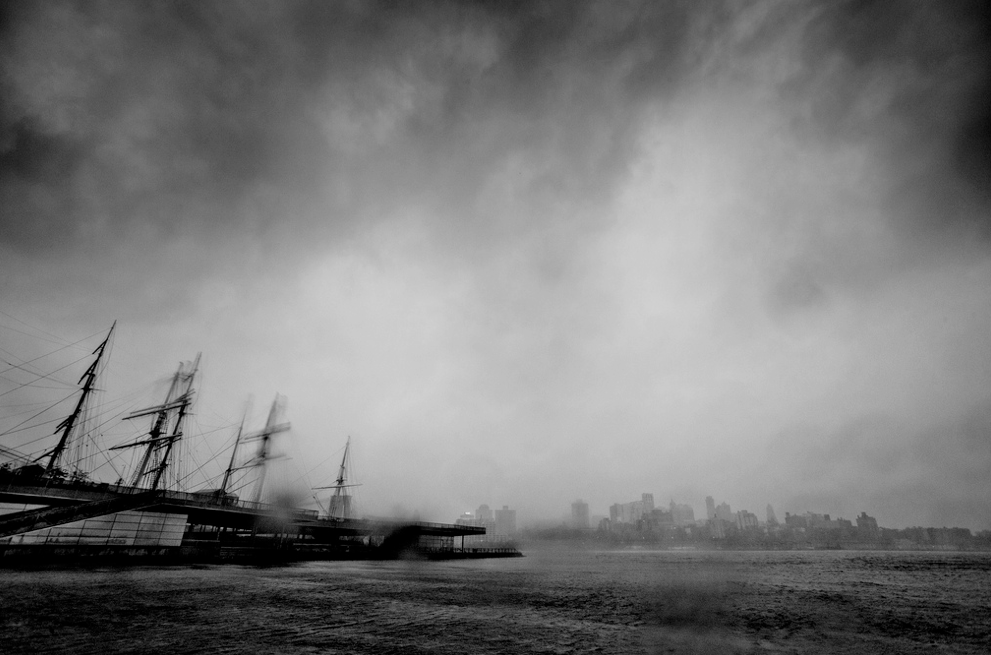
Hurricane Sandy rolls into New York City (Photo: Zoriah)
CURWOOD: What about things like marshes and rain gardens on roofs in the city, permeable concrete on roofs to help deal with the run-off. How much should we be thinking about those kinds of things?
SCLAR: All of those are good ideas. Those are things we teach, those are things we preach, green roofs, painting roofs white to better reflect heat, forms of more permeable concrete in parking lots. All of those things are things that we talk about but we’re going to have to go a lot further. It’s technical, but it’s also social. It’s got to be social policy, it’s got to be land-use policy, it’s going to have to be infrastructure policy, and it really is going to have to be the use of government incentives.
We have to begin to incentivize people to live in walk-able and bike-able communities. Right now all the incentives that we have are to build more highways and to move more people out – and that isn’t just an American problem. I’m confronting the same problem on doing planning in African cities, in Nairobi right now.
This really is going to take developing a broad-based understanding about what these issues are, and I think that we have an opening for this dialogue right now. It really is a question of bringing the society together and I think things like the common threat of something like the storm gives us a shot at it.
CURWOOD: What about the question of rebuilding infrastructure that has been damaged by the storm? And how many of the places that have been damaged should we even think about rebuilding?
SCLAR: That’s one of those questions I teach my graduate students to begin answering by saying: Well it depends! You have to really look critically at the infrastructure in those places and begin to think about: what can be rebuilt where?
That’s one of those questions I think that we’re going to be asking and I think we have to ask, but it’s not a question that you just say in a general sense: well, we’re going to have to get rid of things. Well, we’re going to have to learn how to adapt things more.
CURWOOD: With rising sea levels and storm surges increasing, how do you incentivize living away from the water?
SCLAR: You’ve got to break that into two parts. Certainly, for higher income groups, the notion of waterfront living has been something that has been very attractive. It is attractive to live by the water and to sit by the water… water can be very calming and soothing. But one of the things that we have to do is we have to talk about insurance and saying that… if you want to live there, you have to pay for it. You have to bear the risk if that’s your choice.
But I would be cautious about that because there are a lot of people on Staten Island who are living by the water who are not affluent people. There’s a lot of working-class and poor communities that are in those places because they were low-lying places. The 9th Ward in New Orleans, was not a ‘tony’ neighborhood. So those people do not need to be lectured to and told that they’ve made bad choices. They made the best choice given the options that were open to them.
And what we have to do is talk about this not as just an issue of environmental policy, but it’s an issue of social policy as well. We have to really talk about how we create opportunities for housing that works in other places. We have to really begin to pull this apart in a much more communal and democratic way.
CURWOOD: Elliott Sclar, what’s the silver lining to all this?
SCLAR: You know, where you stand has a lot to do with where you sit, I guess. The people who’ve been badly wiped out, I don’t think they see any silver linings. For people who have lost their homes, who are sleeping on cots in shelters right now, who were living comfortable lives up until a week ago, I’m not sure they see a silver lining.
For those of us who do urban planning and sustainability, what we see is a chance to make people understand why we are so concerned about climate change, why we have been sounding the alarms that we’ve been sounding, why we’ve been trying to get the attention of politicians. So, if that’s a silver lining, we got it!
CURWOOD: Elliott Sclar is Director for Sustainable Development at Columbia’s Earth Institute, Professor, thanks so much for taking this time!
SCLAR: My pleasure.
[MUSIC]
Biking in the Storm

Commuters on the Manhattan Bridge on Thursday, Nov. 1, 2012. (Photo: Andrew Hinderaker)
CURWOOD: Well, assaulted by an unprecedented storm surge, many tunnels connecting New York to outer boroughs flooded and choked the city’s public transportation network. And with power out in much of the region, gasoline was hard to find. But hey - it's New York - so people found ways to get from here to there. For an unprecedented number - the answer was the bicycle. Here's the Director of bicycle advocacy at Transportation Alternatives in New York, Caroline Samponaro.
SAMPONARO: What we saw was a breakdown in the public transit system and our subway system, which is really our backbone. What we also saw was New Yorkers taking to bicycles in huge numbers. So, for example, on the East River bridges, bicycle volume increased from 10,000 to 30,000 cyclists last week, which is a huge increase.
CURWOOD: How might increasing the capacity for bikes in a city like New York help make it more resilient?
SAMPONARO: I mean, I think what we have in New York City is a perfect city for bicycling. When you’re talking about transferring trips from cars to bicycle in the city, the vast majority of trips are under five miles, which is a very bike-able distance. At the crux of actually changing behavior is making bicycling more favorable, is making bicycling easier, safer, more feasible for these trips.
During a storm, when, you know, our underground got flooded out, the streets became really important, and how we use our streets becomes really important. So, whether that’s creating HOV lanes, or dedicating lanes to rapid bus service, or making sure that it’s safe to bicycle through dedicated space, these are all really important steps to take to cut emissions and create effective ways to get big groups of people around.
CURWOOD: So, what has New York done so far to make itself more bike-friendly? I noticed in mid-town especially on the east side, not so much by way of bike lanes.
SAMPONARO: Yeah, I think what we’ve seen over the last five years in particular is a build-out of the bike network. So, we’ve seen around 300 miles of bike lanes added. We’re going to have the largest bike-share program in North America next year, starting in the spring.
I think, you know, the missing middle is really continuing to build out the grid of protected bike lanes that will encourage people that are scared to ride on city streets with cars, to encourage them to get on their bike and make that two-mile or three-mile trip on their bike.
CURWOOD: So, in New York, here are the obstacles: You’ve got potholes, no really safe place to park the bike at the other end, actually it’s kind of tough to get a bike all the way up to a fourth or fifth floor walk-up. What can the city do to make it friendlier for people who want to bike?
SAMPONARO: I mean, that’s absolutely true, I mean, lack of secure bike parking is a deterrent for most people to choose biking daily. And I think bike-share will solve some of that in terms of you don’t have to actually solve the parking problems, but Transportation Alternatives has worked hard to make commercial bike access easier. So, there’s a law in the city that now requires commercial buildings to provide access to bicycles. There also needs to be some innovations. Maybe there needs to be some secure bike parking at transit, or additional accommodations, because the bike parking thing is huge, as you pointed out.
CURWOOD: What effect do you think Sandy could have on bicycling in the long term, I mean, is this possibly a silver lining of Sandy to have more awareness about bikes and what should be done?
SAMPONARO: There’s definitely the possibility of that. I think the large increase in the number of cyclists, of individual cyclists - I mean, who knows… hopefully they’re going to be stuck on the convenience and affordability and practicality of riding a bike to work. That’s our hope at Transportation Alternatives.
I think for the city, and its entire transportation network, a storm like this is a wakeup call to really think in a forward-thinking way about how we can make our transportation network last through storms but also be sustainable. Be working against climate change as opposed to contributing to it. That means, thinking about how our surface public transportation can be part of the solution during the aftermath of a storm like this.
CURWOOD: Caroline Samponaro is a bicycle advocate for Transportation Alternatives in New York City, thank you so much, Caroline.
SAMPONARO: Thank you.
Related link:
Transportation Alternatives info about biking in NYC after Sandy
Power Shift - Bike Sharing in Boston
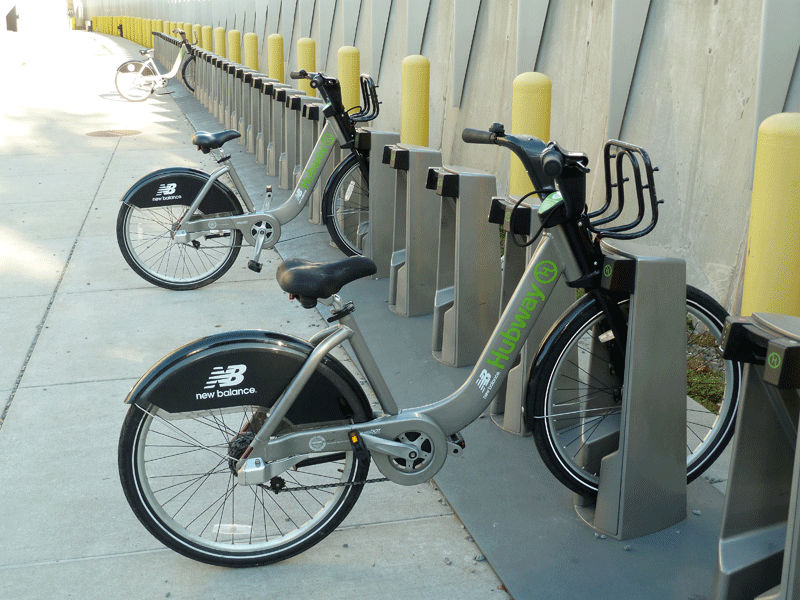
By the end of the morning rush hour there are just 3 bikes left at North Station. The busy commuter line starts the day with 47 bikes, and is replenished as many as three times. (Photo: Bobby Bascomb)
CURWOOD: And as Caroline Sampanaro was saying - a bicycle was one of the few reliable ways to get around in the aftermath of Sandy. But New Yorkers would have found it much more convenient if the Big Apple had already joined the dozens of cities worldwide with a bike-sharing program. Boston – where Living on Earth is based – has one, and Bobby Bascomb went to check it out.
BASCOMB: In Boston there are a few basic ways to get around the city. You can walk or drive.
[SFX TRAFFIC SOUNDS]
BASCOMB: You can take the subway.
[SFX: ANNOUNCER: THE DESTINATION OF THIS TRAIN IS BRAINTREE. NO SMOKING PLEASE]
BASCOMB: Or you can take the Hubway, Boston’s public bike system.
MAN: Hey how are you?!
BASCOMB: I’m good, how are you?
MAN: I’m doing well!
BASCOMB: It’s a sunny fall day at the North Station TD Garden Center. This is where the Celtics play basketball and where thousands of commuters arrive in Boston from the North Shore. Like a lot of people, Peter Dolan uses the Hubway for the last mile of his commute.
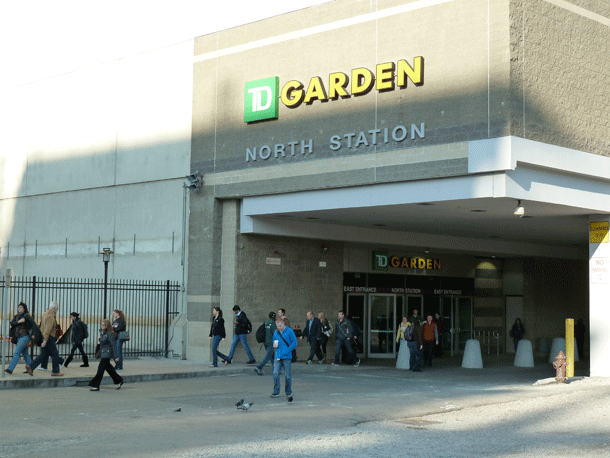
The TD Garden, North Station is where the Celtics play and a central rail hub for commuters in Boston. (Photo: Bobby Bascomb)
DOLAN: It’s such a nice day and it’s about a 15-minute ride to my office from here so I think I ought to take advantage of it before they put them away for the winter. I think it’s a nice relaxing way to start the morning.
BASCOMB: The Hubway is a system of over 1,000 sturdy bikes at 108 docking stations across Boston and the adjoining cities of Somerville, Cambridge and Brookline. For $85 a year Hubway users get a key fob about the size and shape of a flash drive. Rochelle Borgo, from Salem, explains how it works.
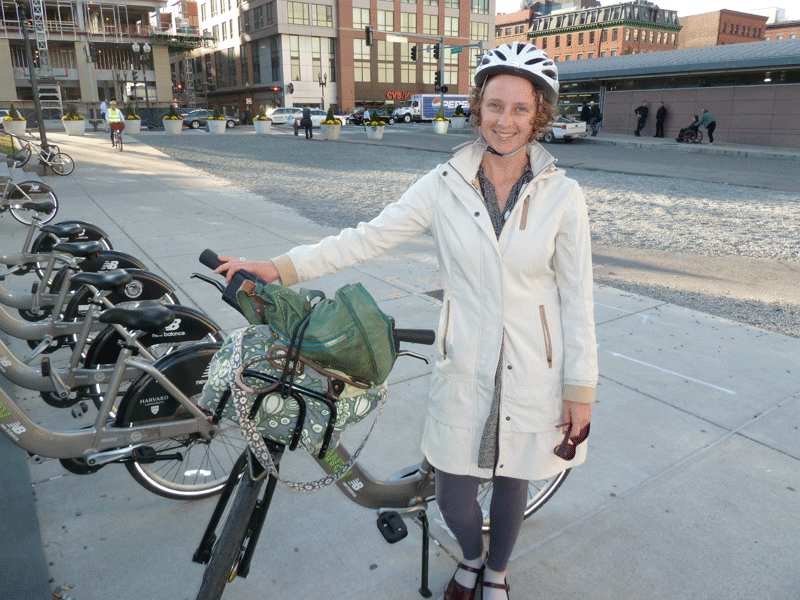
Rochelle Borgo uses the hubway for the last mile of her commute from Salem to downtown Boston. (Photo: Bobby Bascomb)
BORGO: You just insert it into the opening at any dock. It turns green if the bike is available. It turns red if the bike is in need of repairs. And it’s unlimited 30-minute rides throughout the city. As a commuter, I can get everywhere I need to go under that 30 minutes. I’ve only had to pay for a ride 2 or 3 times. Actually there’s one time I got charged because there were no docks available here. And when there are no docks available you either have to wait or ride to another station.
BASCOMB: For Borgo, riding a bike is just more pleasant than taking the subway.
BORGO: The idea of being underground for 20 minutes when it’s still sunny and nice and not pouring and not snowing is just moderately depressing and this is such a great liberating option. It’s just another way to feel like a ten year old again as well. You get to play and be free and be in the fresh air. I love it!
BEVERLY: It’s awesome!
BASCOMB: Jim, from Beverly, says a hubway bike is the fastest way for him to get around the city.
BEVERLY: My office is down by South Station. It’s at least a 15 minute walk and the Hubway is a 6 minute ride.
BASCOMB: Is there a train that goes down there too?
BEVERLY: Oh God no! You’d have to take the green line to the red line or the orange line. It’s all sorts of connections. It’s a pain in the ass. I catch so many trains now. Trains I used to miss when I was walking. It’s incredible, get home to the wife and family so much faster.
BASCOMB: The North Station commuters were so enthusiastic I had to try it myself. For 5 dollars, a day user gets a 5 digit code and can use the bikes for 30-minutes at a time for 24 hours.
[CODE BEEPS UNDER PREVIOUS GRAPH THEN BIKING SOUNDS UNDER NEXT GRAPH BELL RINGS]
BASCOMB: The hubway bikes have three gears and a big fat seat. Your grandmother could ride one and be comfortable. As I zipped by cars stuck in traffic I thought… ‘Suckers! You could be riding a bike!’
I rode over to Boston Common and the State House and then to the Boston Public Library at Copley Square. Then turned the bike in before I got charged for going over 30 minutes. Then I headed over to the Boston City Hall to meet Kristopher Carter, interim director of Boston Bikes, and advisor to the Mayor.
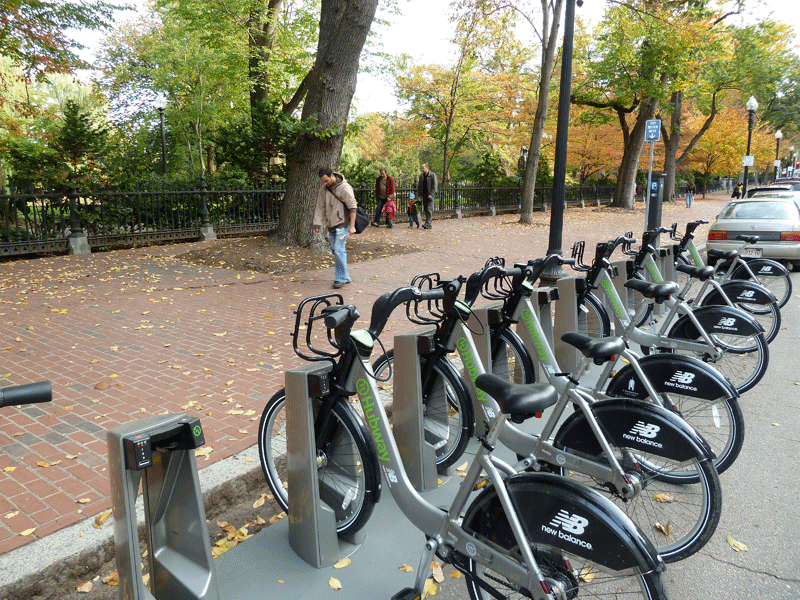
The Hubway station near the Boston Common. (Photo: Bobby Bascomb)
CARTER: There’s definitely an environmental component of it, where we’re looking at, you know, improve air quality and reduce carbon emissions. There’s also a healthy lifestyle component we’re looking at too. Some of the funding is targeted around anti-obesity. You know if you can get to work or get to school by pedaling a bicycle that’s certainly one way of tackling the epidemic we have in this country.
BASCOMB: It’s hard to say how much weight has been lost or carbon reduced by the more than 600,000 Hubway trips taken so far. What is certain is the price. The initial investment for the Hubway was roughly six million dollars. It’s in the red right now but Carter expects it will start turning a profit within three years. Start up funding came from state and federal grants as well as corporate sponsors led by the athletic shoe company New Balance, which gave 600,000 dollars. Matthew Le Bretton is director of public affairs for New Balance Athletic Shoe Company.
LE BRETTON: We really believe, as a company, that getting people moving no matter how they do it, whether it’s walking up a flight of stairs or riding a bike, is really important to our overall health and to our city’s health. Alternative modes of transportation is a great thing and we’re proud to sponsor that and support it.
BASCOMB: In the last 5 years Boston has added roughly 58 miles of bike lanes. There are plans to extend the bike share program to other neighborhoods such as Jamaica Plain and Roxbury.
So far this year in Boston there have been 450 accidents involving cars and bikes, including three fatalities. No Hubway users were killed and only two were involved in accidents that required EMS services. One criticism leveled at Hubway is that it doesn’t provide helmets. But Kristopher Carter says they are working on it.
CARTER: We’re working with a group out of MIT that’s formed a company to do helmet vending machines. We are hopefully going to be able to pilot one of those vending machines next spring.

Day users can swipe their credit card and for five dollars have access to a bike for 24 hours. (Photo: Bobby Bascomb)
BASCOMB: Another problem is ensuring that bikes are always available when and where the commuters need them. That’s where Myles Dakan comes in.
DAKAN: That’s my usual job is to go around and make sure the bikes are where they need to be. Often I’m on the morning shift so making sure people going on their morning commute have bikes where they need them and places to put them where they’re heading.
BASCOMB: Myles works for Alta Bike Share, the contractor that administers the program and maintains the bikes. The hubway dock at North Station empties out two or three times during the morning rush hour so he’s busy driving vans full of bikes to replenish the racks. Mackenzie Stunkard is the Fleet Coordinator, or dispatcher for the Hubway. She sits in front of a computer with a map of the city.
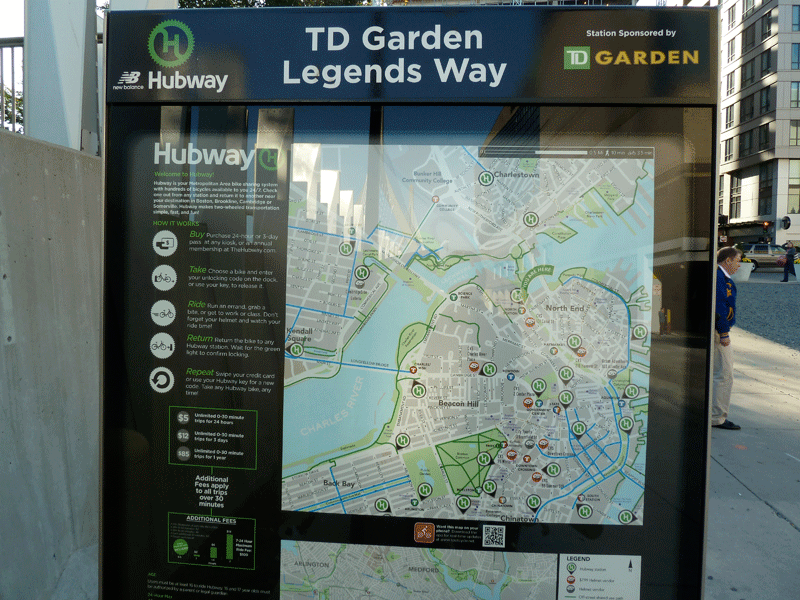
A map at each Hubway station shows users where they can return their bikes. (Photo: Bobby Bascomb)
STUNKARD: This is a live map of the system. So it has an up-to-date view of all the bikes. And then I also have GPS locations of all the drivers.
BASCOMB: So, each little green dot on the map here represents a station?
STUNKARD: Correct and it’s shaded gray where there are available docks and green where there are available bikes.
BASCOMB: Hubway users have access to the same information on the website. And there’s a smart phone app. so riders can see in real time where there are bikes and docking stations available. It’s that kind of technology that’s allowed bike share programs to really take off. Scott Mullen is General Manager of the Hubway.
MULLEN: Bike sharing in general really got a boost in ’06. It’s called bike sharing 3.0. It’s credit-card transactions. A really secure, robust locking system. And that was really Velib in Paris. I think to this day they have about 20,000 bicycles. It’s really a mode whose time has come.
BASCOMB: Mullen says bikes are also a critical component for emergency management that will help make the transportation system more resilient. Most of the Hubway racks are solar-powered so bikes can still be released and returned if the electricity grid goes down.
MULLEN: After the blackout that happened a few years ago that literally crippled most of the East Coast and New York City was in the dark, most of my friends said ‘it didn’t phase me at all. I just rode my bike like I normally do. I just had more pedestrians to watch out for.’
BASCOMB: There are currently about 25 bike share programs in the US and nearly 200 world wide, from China to Germany to Argentina. Mullen says that number is only going to go up.
MULLEN: Bike sharing is a rocket ship. Every smart city is looking at it. If you think about transit investment it’s the best bang for the buck by a factor of 100. What’s the most efficient way to move the most amount of people? And then if you think about the public health aspects. I don’t know of many other modes that are as much a magic bullet as cycling is.
[BIKE RIDING SOUNDS BELL]
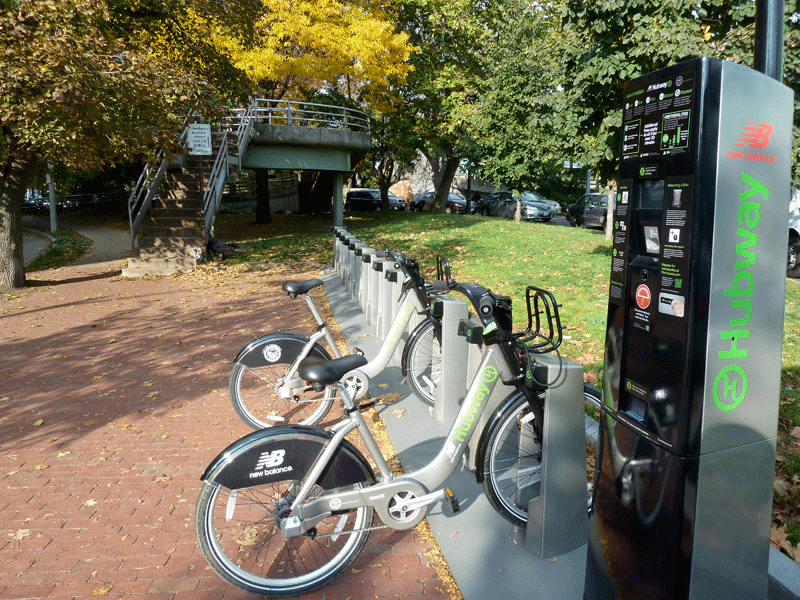
The Hubway station near the Charles River. (Photo: Bobby Bascomb)
BASCOMB: The Hubway bikes will be out on the streets here in Boston until the end of November. Then they’ll go back to the warehouse for a thorough tune up and winter storage. The 10,000 commuters at North Station and around the city will just have to wait for the spring thaw in March to get back on their bikes. For Living on Earth, I’m Bobby Bascomb.
Related links:
- Hubway
- Federal Report on Bike Sharing in the US and Guide to Starting Bike Share Programs
- The Pedestrian and Bicycling Information Center
[MUSIC: John Cale “Bicycle” from Hobosapiens (EMI Records 2003).]
CURWOOD: Coming up, a new novel from Barbara Kingsolver starts with a mystery – shrouded in beauty and the lure of betrayal. Keep listening to Living on Earth!
[CUTAWAY MUSIC: Don Grusin: “Makossa Beat” from GRP 30: The Digital Master Company 30th Anniversary (Verve Music 2012).]
ANNOUNCER: Funding for Living on Earth comes from the Grantham Foundation for the protection of the environment, supporting strategic communications and collaboration solving the world’s most pressing environmental problems. The Gordon and Betty Moore Foundation. The Kendeda Fund furthering the values that contribute to a healthy planet. And Gilman Ordway for coverage of conservation and environmental change. This is PRI, Public Radio International.
BirdNote ® Spoon-billed Sandpiper
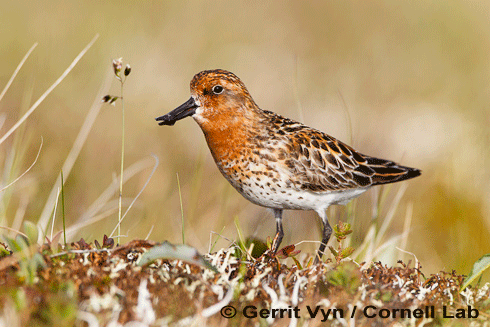
CURWOOD: It's Living on Earth - I'm Steve Curwood.
[MUX - BIRDNOTE® THEME]
CURWOOD: Of all the threats to our natural world, humans, and our insatiable development, may be the most deadly. That's what sound recordist and photographer Gerrit Vyn of the Cornell Lab found on a visit to Russia's far north.
[SONG OF THE SPOON-BILLED SANDPIPER]
VYN: That’s the song of one of the rarest birds on earth – the Spoon-billed Sandpiper. I recorded it in the far northeast of Russia where as few as 100 remaining pairs of this mysterious little sandpiper, with a remarkable spoon-shaped beak, go to breed each summer.
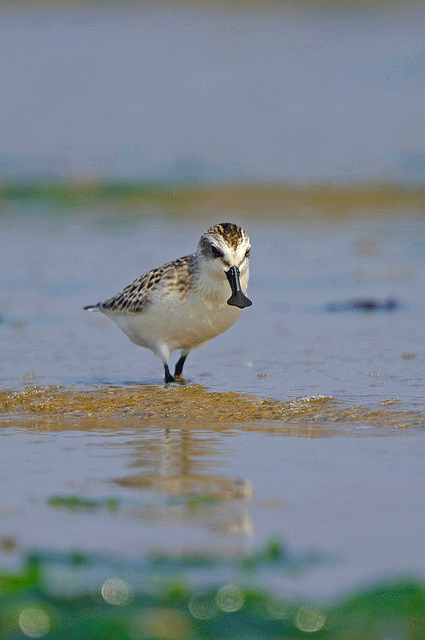
The Spoon-billed Sandpiper non-breeding plumage. (Photo: © Nkenji flickr)
[RHYTHMICALLY REPEATED CALL OF SPOON-BILLED SANDPIPER]
VYN: The Spoon-billed Sandpiper depends on key coastal wetlands to fuel its long distance migration to its wintering areas. And for many species migrating south on the flyway from eastern Russia and Alaska, to Southeast Asia, Australia and New Zealand, the Yellow Sea is “Grand Central Station” for birds. They all stop there to refuel and continue their journeys.
[FLOCK CALLS OF DUNLIN]
VYN: But the Yellow Sea is not what it used to be – massive projects in China and South Korea for agriculture, aquaculture, and industry have eliminated more than half of the intertidal areas that all of these migrants depend on. And for many, their populations are rapidly falling. The Spoon-billed Sandpiper may soon be extinct.
[ADULT SPOON-BILL NEST CALLS]
VYN: I came to know a handful of these beautiful birds in the velvety hills of Siberia as they sang, courted, and eventually settled down to nest. I sat on the tundra with a Spoon-billed Sandpiper as its eggs were hatching and watched as the downy doe-eyed chicks took their first feeble steps into our rapidly changing world.
[SONG OF THE SPOON-BILLED SANDPIPER]
CURWOOD: Gerrit Vyn works as a natural history sound recordist at Cornell.
There are pictures of Endangered Spoonbills at our web-site, loe dot org.
[Vocalizations of the Spoon-billed Sandpiper provided by The Macaulay Library at the Cornell Lab of Ornithology, Ithaca, New York. Song of Spoon-billed Sandpiper [166364], Rhythmically repeated call [166371], calls of adults and chicks at nest [166378] recorded by Gerrit Vyn; flock calls of Dunlin [59435] recorded by W.W.H. Gunn.
Producer: John Kessler
Executive Producer: Chris Peterson
© 2012 Tune In to Nature.org November 2012 Narrator: Gerrit Vyn]
[MUSIC: Robert Glasper “Butterfly” from Double Booked (Blue Note Records 2009).]
Flight Behavior
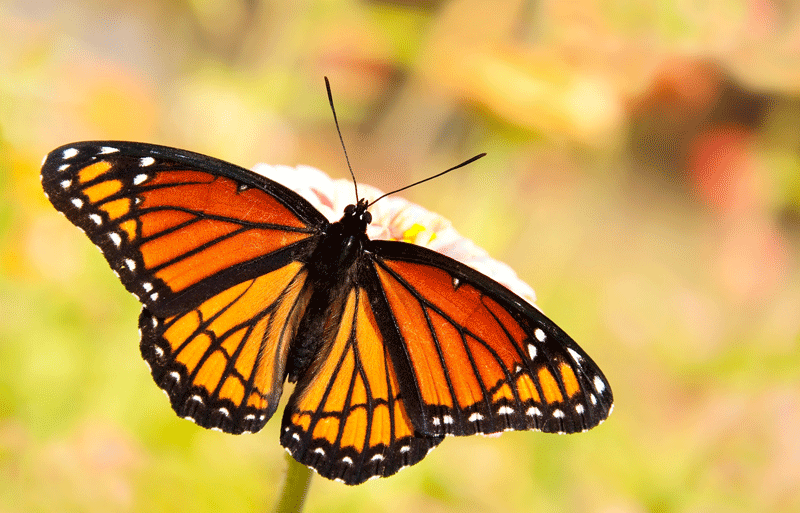
Female monarch butterfly (Danaus plexippus)(Bigstockphoto.com)
CURWOOD: Award-winning author Barbara Kingsolver has written more than a dozen books, including The Bean Trees, The Poisonwood Bible, and Prodigal Summer. We talked to her back in 2007 about "Animal, Vegetable, Miracle" -- the true story of moving her family from Arizona to Virginia and pledging to eat only locally grown food for a year. Well, Barbara Kingsolver’s newest novel, Flight Behavior, is also set in Appalachia, in Tennessee. Barbara, thanks for coming back here to tell us about it!
KINGSOLVER: Thanks, it's great to be back here!
CURWOOD: Well, first off, how are things on the farm? I understand you’re still living in – what is it? – Western Virginia? and eating only whatever it is that you and your neighbors can grow?
KINGSOLVER: Southwestern Virginia, right. Regionally we’re in southern Appalachia. There are a lot of farms around us, and so, yes, we really have no trouble at all surviving on locally produced food.
CURWOOD: And so, you raise sheep, you have…

Barbara Kingsolver (Photo: David Wood)
KINGSOLVER: We raise sheep for both wool and meat, and we have a large vegetable garden, but so do almost all of the people around us.
CURWOOD: Well, I have to say that your latest book: Flight Behavior, starts of, well, it’s kind of mysterious. Your protagonist, Dellarobbia, is headed off into the woods, it’s a back lot on her Tennessee sheep farm, and she’s on her way to meet a man and have an affair! She’s going to give up her kids, she’s going to give up all of that farm life, but then she sees something that makes her change her mind. Can you tell us about that?
KINGSOLVER: Yes. She’s marching up this mountain, she’s at the end of this rope, she doesn’t really want to wreck her life but she has to wreck her life. She’s stopped along the way at the sight of what looks to her like a valley of trees on fire. These trees are all glowing orange. And, she becomes convinced that it’s a miracle, it’s like her burning bush, and she turns around and runs back down the hill, picks up her kids and decides to straighten up her life. Well, soon enough she finds, it’s not a miracle, it’s a freakish biological event caused most likely by climate change… and I hate to give away what it is, but…
CURWOOD: So, final warning here, turn the radio down for a few minutes and come back if you want to be surprised.
KINGSOLVER: Spoiler alert!
CURWOOD: Otherwise, go ahead, tell us what it was…
KINGSOLVER: It’s an immense congregation of Monarch butterflies. Normally, these butterflies congregate, aggregate for the winter in the high mountains of central Mexico. In this case, I imagined a circumstance in which their migratory system is so disrupted that they would shift their aggregation to very similar mountains in southern Appalachia. What would happen if this happened is it would be touch and go because this is a much colder winter in southern Appalachia. And most likely what is going to happen in the course of this winter is the whole species is going to freeze to death.
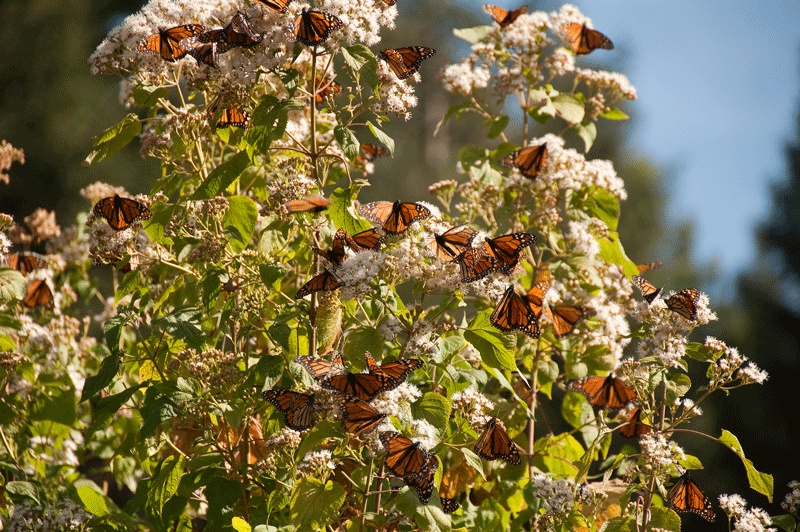
Butterflies congregate at the Michoacán butterfly reserve in Mexico. (Bigstockphoto.com)
CURWOOD: So, of course, you, Barbara Kingsolver, you’ve trained deeply in science…
KINGSOLVER: I have a Bachelor of Science, a Master’s in Ecology and Evolutionary Biology, and actually, I was in a PhD program… I got… I did everything but finish the dissertation, I defected at the last minute when I sort of realized that this dissertation, if I finished it, would probably reach and impress - maybe 11 or 12 people in the world. And I had this idea I could shoot for an even bigger audience than that.
CURWOOD: In this novel, Flight Behavior, you spend a lot of time on science. It may be a fiction that the Monarchs are taking up residency in Tennessee, but after that all of the science that you have in there, to my read, is accurate.
KINGSOLVER: Thank you.
CURWOOD: Tell me more about the science of these Monarch butterflies and why you used this as a teaching tool for Dellarobbia and the people around her.
KINGSOLVER: I just had this vision of the Monarchs roosting in an Appalachian hollow. That’s sort of the magic of writing a novel is 99 work and one percent magic. But I recognized immediately that it would be a really great prime mover for a novel because there is so much truth, already. There are plenty of well-documented circumstances in which animals that are less adaptable than we are are getting shifted in ways that are both incongruous and fatal to them.
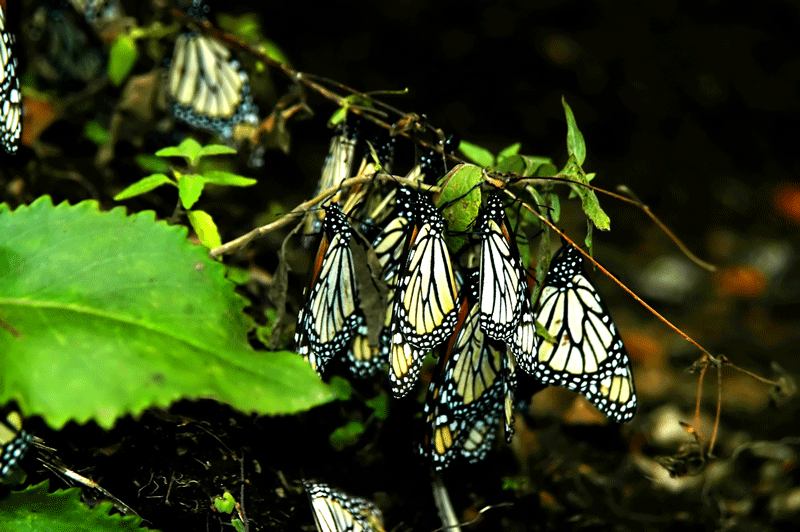
Hibernating monarch butterflies. (Bigstockphoto.com)
At one point, Dellarobbia in this novel is trying to explain what she has learned, because she comes to be, actually, in the employ as sort of a low-level lab tech for this scientist who comes in to study this. So, she’s sort of learning all this stuff and she’s trying to translate it into terms that her friends and her poor husband, Cub – he’s kind of a dim bulb, he’s not very bright, but he’s very sweet – she’s trying to explain it and she says, ‘it’s like they’re directed by cues that they can’t change - they have to follow the signs.’
So, she says ‘it’s like if you followed the signs to the grocery store every week, and you went to the Food King. And then one day you followed the same signs exactly the same way and you ended up at the auto parts store, what would you eat?’
CURWOOD: The science around these Monarch butterflies is really fascinating. That they make these generational migrations, for instance, can you tell us more about that?
KINGSOLVER: It’s something to knock your socks off. The Monarch is in your yard, in the fall, maybe in Connecticut or Maine or Minnesota… that Monarch that is about to turn around and head for Mexico – has never been in Mexico. Its parents were never in Mexico.

Male monarch butterfly (Danaus plexippus) (Bigstockphoto.com)
So, if you picture this as a big circle, the Monarchs that spend the winter in Mexico, on those high, cool mountains, suddenly wake up in March, they go crazy in this mating frenzy, and the females head for dear life towards Texas, towards the first unfurling milkweed plants in what’s called the spring range across southern Texas. They get there just in time to lay eggs and die.
Then the next generation hatches, eats those milkweed leaves, flies a little further north, sort of where spring is coming and where milkweeds are coming up across the southern tier of the United States. They die, those eggs hatch into butterflies that fly even further north, all the way up into Canada. They die, and then their offspring go back to Mexico. How does a brain the size of a pinhead tell them how to get some place they’ve never been – year after year, century after century – they’ve been doing this for thousands of years. And now, suddenly it is getting disrupted.
Not precisely as I’ve portrayed it in this novel, but that is a potentially real scenario. I tracked down, I did a lot of research on Monarchs, obviously, and I tracked down the world’s foremost experts, notably Dr. Lincoln Brower, and I laid this scenario on him, and I was afraid he would laugh me out of the laboratory. But no! I said… ‘is this at least plausible?’ And he said, ‘yes it is, and lets talk about why and how that could be true.’
CURWOOD: And is that when you walked out of his lab feeling really sad?
KINGSOLVER: Yes and no. I knew when I entered this novel, how serious this is. How far along this scary road we have gone. There’s a moment in this novel when Ovid is trying to explain to the reporter how bad things are, he says: ‘We are perched at the top of Niagara falls, we can’t just take a leisurely swim back upstream when we get over our denial. Does this strike you,’ he asks, ‘as a good time to be debating the existence of the falls?’
I know where we are, I’ve been following this a long time. I’m a scientist, I believe science. I guess it makes me feel a little better to know I’m talking about it, I’m not in denial. I’m doing the best I can to encourage a conversation and maybe illuminate some of the reasons why we’re failing to converse. That’s the best I can hope for.
CURWOOD: So, let’s talk a little bit about your protagonist here, Dellarobbia, she got into this marriage that she was going to throw away, well, it was a shotgun wedding.
KINGSOLVER: Right. Well, whatever big ideas she might have had about her life in high school, she gave up when she got pregnant and married at 17. So she’s very constrained by her circumstances. So, this event brings Dellarobbia, for the first time, in contact with journalists from the outside world, with tourists, with scientists, and really with science. With a scientific way of evaluating what she sees.
CURWOOD: Now there’s a great example in your book that I think really exemplifies the different camps that people fall into when it comes to believing in climate change. It starts on page 320, Dellarobbia is talking to Ovid, the butterfly scientist… could you read that for us please?
KINGSOLVER: Sure. He says, “Science doesn’t tell us what we should do, it only tells us, what is.” And Dellarobbia responds, “well, that must be why people don’t like it.” Ovid seems startled, “they don’t like science?” “I’m sorry, I’m probably speaking out of turn here, you’ve explained to me how big this is, the climate thing. That it’s taking out things we’re counting on, but people are saying, ‘just forget it.’ My husband, guys on the radio, they say it’s not proven.”
Ovid says, “What we’re discussing is clear and present, Dellarobbia, scientists agree on that. These men on the radio, I assume are non-scientists. Why would people buy snake oil when they want medicine?” “That’s what I’m trying to tell you. You guys aren’t popular. Maybe your medicine is too bitter. Or you’re not selling to us. Maybe you’re writing us off thinking we won’t get it.”
Ovid nodded slowly, “We were not always unpopular, scientists. 15 years ago people knew about global warming, at least in a general way, you know,” he said, “In surveys they would all answer: Yes it exists, it’s a problem. Conservatives or liberals, exactly the same. Now there is a divide.”
“Well, yeah,” Dellarobbia says, “People sort themselves out, like kids in a family, you know? They have to stake out their different territories, the teacher’s pet or the rascal. I’d say the teams get picked and then the beliefs get handed around. Team camo, we get the right to bear arms and John Deere and the canning jars and tough love and taking care of our own. The other side wears, I don’t know what, something expensive. They get recycling and population control and lattes and as many second chances as anybody wants.” Dr. Byron looked stupefied.
CURWOOD: Dellarobbia is a character I find just fascinating. People who would like to sell a lot of books in America typically don’t write about really poor people. And Dellarobbia is pretty close to the bottom; I mean, she’s struggling to even buy her kids presents for Christmas in the dollar store.
KINGSOLVER: You’re right. Poverty is an important part of the grounding of this novel, and this is the culture I wanted to describe and then move you into a conversation with yourself about environmentalism. And I think the environmental movement in this country, and in the world, may often been failing to take into account class.
CURWOOD: Indeed! Because, you have this scene a bit later, she’s with an activist who’s come to her farm, he’s handing out leaflets and he’s trying to get people to reduce their carbon footprint, but it turns out she’s doing just about everything that’s on her list.
KINGSOLVER: It’s completely irrelevant to her life. I mean, he goes down this checklist that starts with: ‘Take your own silverware when you dine out,’ and she says, ‘I haven’t been to a restaurant in over two years.’ And that restaurant being the Dairy Queen or something. And he says, ‘Well, OK, eat less red meat,’ and she sort of wishes she could eat red meat.
And he says, ‘Turn down the thermostat,’ and she’s trying to keep the electricity on in her house. It’s been shut off several times already during this novel because she couldn’t pay the bills. This is a moment when she is beginning to get that as humans on this earth, we’ve passed some kind of point where we’re going to have to start to rein ourselves in. Rein in our consumption, and she’s seeing that she never got there in the first place. This is what a lot of people on Planet Earth are being asked to do: rein themselves in when they never quite got there in the first place.
CURWOOD: Well, I guess we don’t want to give away the ending here…
KINGSOLVER: We don’t!
CURWOOD: We can’t say whether the butterflies might survive this Tennessee winter or Dellarobbia would want to stay on the farm…
KINGSOLVER: We cannot. We cannot!
CURWOOD: So instead I think I need to ask you, Barbara Kingsolver, what do you do next? Can we expect more works on the environment? Climate change?
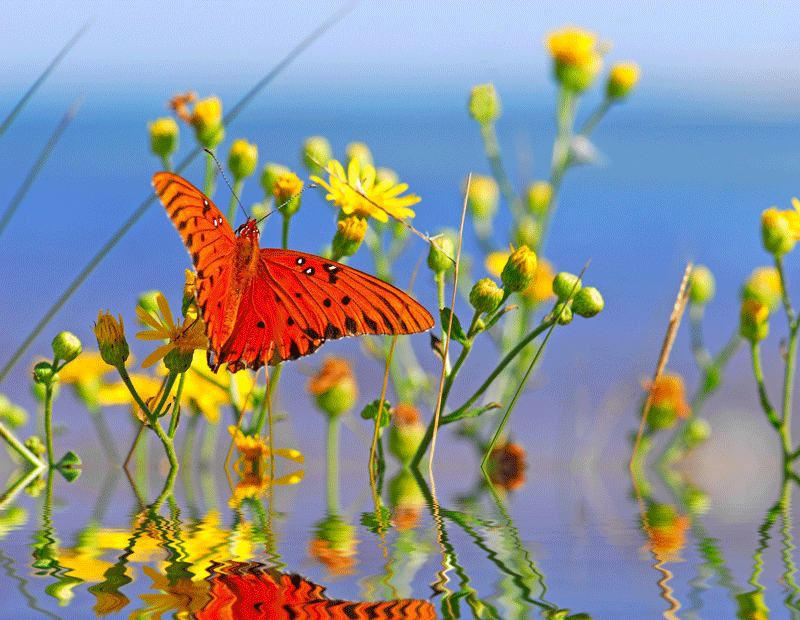
(Bigstockphoto.com)
KINGSOLVER: I think you can. I think you can expect that I will always write about things that seem to matter to me and to matter to my readers because a novel is an audacious act. I’m asking you: OK, set aside your life for 8 or 10 hours and listen to me. I come from a culture of modesty. We southerners don’t say, ‘Sit down and listen to me.’ We say, ‘What do you think of this?’ I promise you, I’m not going to ask you to give yourself over to a whole novel unless it’s going to rattle at the cage of humans on the world a little bit. So that’s what you can expect of me.
CURWOOD: Barbara Kingsolver’s latest book is entitled Flight Behavior. Thank you so much for taking this time today!
KINGSOLVER: Thanks so much, it’s great to be here.
Related links:
- Barbara Kingsolver’s biography
- About Flight Behavior
[MUSIC: Marc Johnson/Eliane Elias “B is for Butterfly”].
CURWOOD: Living on Earth is produced by the World Media Foundation. Bobby Bascomb, Emmett Fitzgerald, Helen Palmer, Annie Sneed, James Curwood, Meghan Miner, and Gabriela Romanow all had a hand in making our show. Jeff Turton is our technical director. Alison Lirish Dean composed our themes. You can find us anytime at L-O-E dot org - and check out our facebook page - it’s PRI’s Living on Earth. I'm Steve Curwood. Thanks for listening!
ANNOUNCER: Funding for Living on Earth comes from Stonyfield Farm, makers of organic yogurt, smoothies, and more. Stonyfield invites you to just eat organic for a day. Details at just eat organic dot com. Support also comes from you, our listeners. The Go Forward Fund and Pax World Mutual and Exchange Traded Funds, integrating environmental, social, and governance factors into investment analysis and decision making. On the web at Pax World do com. Pax World, for tomorrow.
ANNOUNCER 2: PRI, Public Radio International.
Living on Earth wants to hear from you!
Living on Earth
62 Calef Highway, Suite 212
Lee, NH 03861
Telephone: 617-287-4121
E-mail: comments@loe.org
Newsletter [Click here]
Donate to Living on Earth!
Living on Earth is an independent media program and relies entirely on contributions from listeners and institutions supporting public service. Please donate now to preserve an independent environmental voice.
NewsletterLiving on Earth offers a weekly delivery of the show's rundown to your mailbox. Sign up for our newsletter today!
 Sailors For The Sea: Be the change you want to sea.
Sailors For The Sea: Be the change you want to sea.
 The Grantham Foundation for the Protection of the Environment: Committed to protecting and improving the health of the global environment.
The Grantham Foundation for the Protection of the Environment: Committed to protecting and improving the health of the global environment.
 Contribute to Living on Earth and receive, as our gift to you, an archival print of one of Mark Seth Lender's extraordinary wildlife photographs. Follow the link to see Mark's current collection of photographs.
Contribute to Living on Earth and receive, as our gift to you, an archival print of one of Mark Seth Lender's extraordinary wildlife photographs. Follow the link to see Mark's current collection of photographs.
 Buy a signed copy of Mark Seth Lender's book Smeagull the Seagull & support Living on Earth
Buy a signed copy of Mark Seth Lender's book Smeagull the Seagull & support Living on Earth

